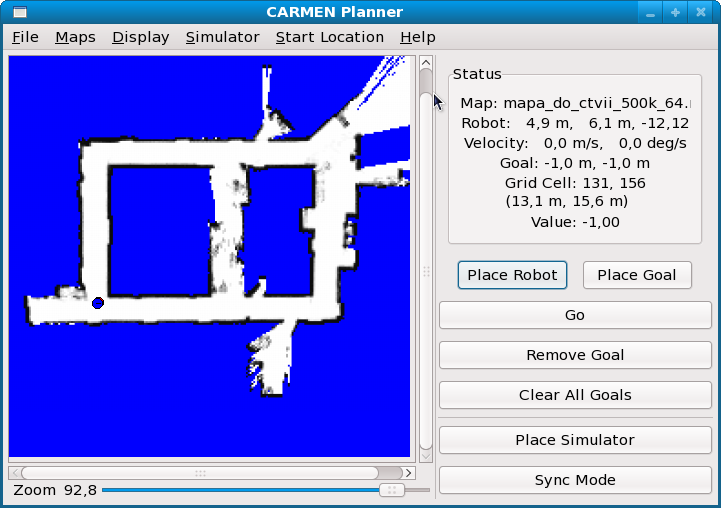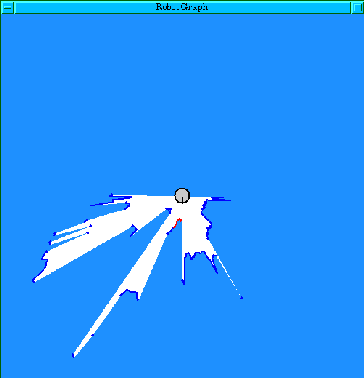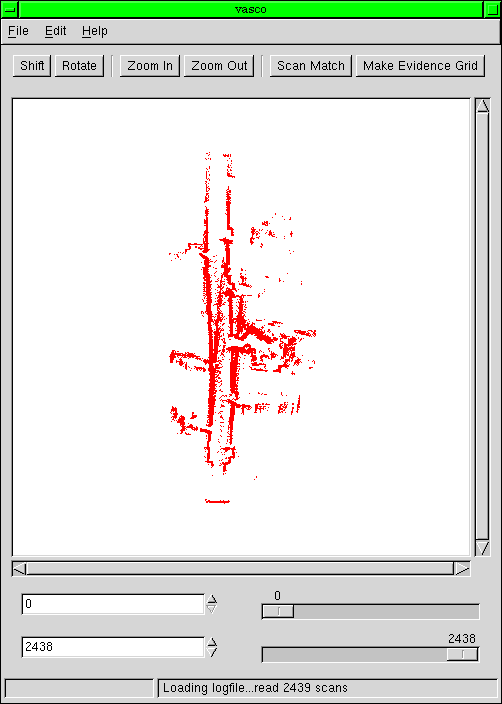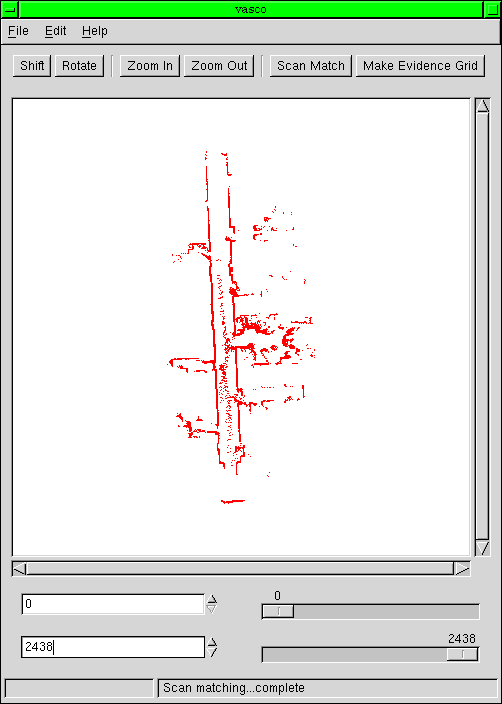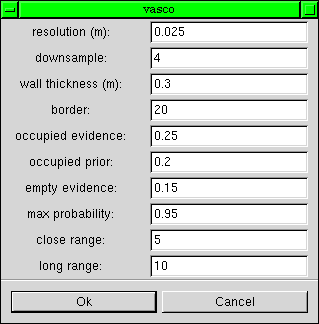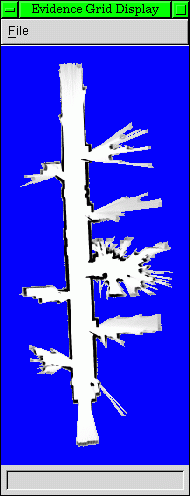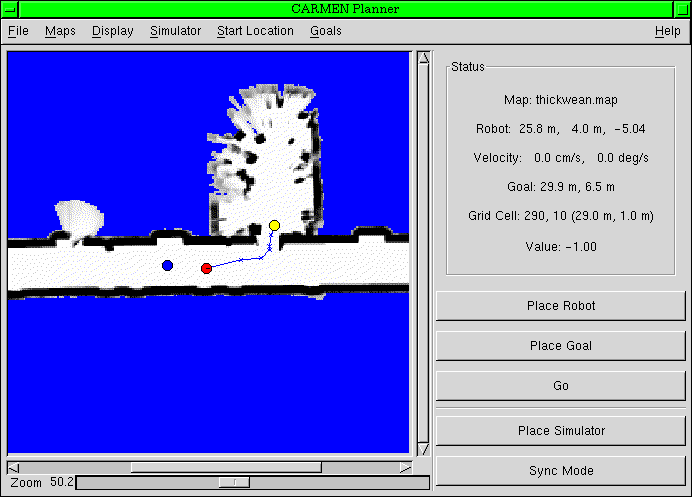Running Carmen
Índice
- 1 Introduction
- 2 Carmen use Scenaria
- 2.1 Running a Simulated Robot
- 2.1.1 In window (xterm) 1, start the IPC central server
- 2.1.2 In window 2, start the parameter server
- 2.1.3 In window 3, start the proccontrol GUI
- 2.1.4 In window 3, start the simulator
- 2.1.5 In window 4, start the map server
- 2.1.6 In window 4, start the robot module
- 2.1.7 In window 6, start the localize module
- 2.1.8 In window 7, start the navigator module
- 2.1.9 In window 8, start the navigatorgui program
- 2.1.10 In window 9, start the robotgui program
- 2.1.11 Running it All Together
- 2.2 Teleoperation of a Robot
- 2.3 Building a Map (using teleoperation)
- 2.4 Autonomous Navigation
- 2.1 Running a Simulated Robot
Introduction
This document is an aid to begin using the CARMEN robot sensing and navigation software, including (but not limited to) the following programs:
This program stores sensor and odometry data with time stamps into a log file.
- playback
This program plays back a log file and send the stored messages to the other modules.
This program allows for creating or editting maps for use by Carmen.
This program provides a graphic interface which shows the robot's position and destiation on the pre-built map and allows setting of the current position and orientation, and selection of destinations.
- param_edit
This program enables the user to change parameters as the robot is running. It also makes it easy to save the changes to a ".ini" file.
- param_deamon
This program provides other programs with information about the robot being used and the area around it. This can include a pre-built map, sensors on the robot, and typical sensor error.
- robotgui
This program provides a simple graphic interface for the robot, allowing direct motion control and a display of current sensor information.
- processcontrol
This program controls the different processes, restarts them in case of a crash, etc.
- simulator
This program provides simulated data generation from a virtual robot. It requires a previously generated map.
- base_services
This program controls the movement of the robot and accepts inputs from the sensors. This program MUST run on the computer attatched to the robot hardware.
- localize
This program uses the sensor information from the baseServer to find the robot position in a map provided by param_deamon.
- navigator
This program enables autonomous navigation.
- vasco
This program creates a map from sensor and odometry data stored in a log file.
- vasco-tiny
A command line scan-matcher based on vasco. It reads log files and outputs a (locally) corrected log file.
The links above will go to other pages with more complete descriptions and instructions for using these programs.
The "central" program, IPC, enables communication between these and other programs. Information on using and coding with IPC can be found at http://www-2.cs.cmu.edu/afs/cs/project/TCA/www/ipc/ipc.html. A simplistic explanation of IPC: various programs "publish" generated information which is then "subscibed to" by other programs. IPC keeps track of what is published and delivers it to the subscribers.
Carmen use Scenaria
The use of CARMEN will described using three different scenaria: simulating a robot and way-point navigation of it in a known map, tele-operating a robot, and building a map. Since CARMEN is modular software, each scenario will involve opening a bunch of different xterms and running different programs (called modules in the LCAD version of Carmen). Alternatively, one can use the program proccontrol to start and control each module.
Before starting, go to the Carmen sub-directory carmen/bin.
Running a Simulated Robot
In this section you will learn how to run a simulation of the autonomous driving car from IARA project. Just follow the steps bellow to understand how each of the modules are initialized for this task. Alternatively, you can do:
cd $CARMEN_HOME/bin/ ./central
(first step) And then, in another tab in the bin/ directory:
./proccontrol process-navigate-volta-da-ufes-pid.ini
This will run all the commands automatically.
In window (xterm) 1, start the IPC central server
./central
If the central server is already running, you might receive the message:
Error: unable to bind TCP/IP socket for listening
You can check if the server is running using the command:
ps -a | grep central
If there is a server running you will receive a message like this:
6446 pts/0 00:00:00 central
You can kill a running central using:
killall central
If you are running programs on multiple machines, then you must specify on the other machines which machine is running central. This is done with the bash command:
export CENTRALHOST=[hostname]
where [hostname] is the name of the machine on which central is running.
Note: When running displays on off-robot computers, running the display programs off-robot rather than on-robot uses less bandwidth than piping the X display across the network.
In window 2, start the parameter server
//////// Atual:
./param_daemon ../src/carmen-ford-escape.ini
The command above will start the param_deamon such that read the parameters for LCAD's robots and modules from the parameter file "carmen/src/carmen-ford-escape.ini". Some of the parameters contained in "carmen-ford-escape.ini" are informations about the localization, mapping and odometry modules, as well as the geometry of the sensors and the car it-self.
Other command-line options are:
- [map_filename] Opens the map to get some information about it
- robot [robotname] directs the server to parameters specific to the robot which should exist in the specified parameter file.
- [mapfile.map] directs the server to a map file specific to the location. If you do not specify a mapfile, then no map will be served.
- [paramfile.ini] specifies a parameter file. If no file is specified, then parameters from carmen.ini will be used. The param_deamon will look first in the current directory, then the parent directory (../), and then ../src/ for carmen.ini.
- [-port portnum] specifies a port to be used for an ANT server
- [-noant] says not open an ANT server
- [-useant] says to use an ANT server
//////// Como Era:
./param_daemon --robot p2d8+ ../data/mapa_do_ctvii_500k_64.map
The command above will start the param_deamon such that it serves parameters for the LCAD robot "p2d8+" from the parameter file "carmen/src/carmen.ini" and the map file "carmen/data/mapa_do_ctvii_500k_64.map." Other command-line options are:
- robot [robotname] directs the server to parameters specific to the robot which should exist in the specified parameter file.
- [mapfile.map] directs the server to a map file specific to the location. If you do not specify a mapfile, then no map will be served.
- [paramfile.ini] specifies a parameter file. If no file is specified, then parameters from carmen.ini will be used. The param_deamon will look first in the current directory, then the parent directory (../), and then ../src/ for carmen.ini.
- [-port portnum] specifies a port to be used for an ANT server
- [-noant] says not open an ANT server
- [-useant] says to use an ANT server
In window 3, start the proccontrol GUI
/////// Atual:
./proccontrol_gui
The command above will open an interface where you can easily monitor the modules running for this simulation. As you run other modules, their names will apear in the screen.
/////// Como era (DEPRECATED):
In window 3, start the simulator
./simulator
This command will start a moderately useful 2-D simulator, intended to replace the base module. It publishes odometry, laser messages and sonar messages. It accepts base velocity commands. The simulator always starts with its robot in the bottom right corner of the map (0,0), but subscribes to localize_initialize messages as well as simulator_set_truepose messages to initialize its robot position.
The simulator can also run an instance of the robot module to provide collision prevention. This, however, needs to be activated in the ini file using the parameter "simulator_use_robot". This parameter is disabled by default, which means that you have to start the module robot separately.
/////// Atual
In window 4, start the map server
./map_server -map_path ../data/map_ida_guarapari-20170403-2 -map_x 7756892.9 -map_y -364045.2 -block_map on -lanemap_incoming_message_type 0
In this case, the map_server program will generate the car's poses and the map from the informations contained in ../data/map_ida_guarapari-20170403-2 directory. Alternatively, you could directly load this informations from a file, with the '-map' command-line option.
Essential command-line options:
- -map [map-file] : Load an offline map from the [map-file].
- -map_path [path] : Enter the path to the offline map directory.
- -map_x [float] : map's x global position.
- -map_y [float] : map's y global position.
- -block_map ['on'/'off'] : enable the generation of the map with the data inside the [path] directory.
/////// Como era
In window 4, start the robot module
./robot
Robot is a module that provides an abstract view to the hardware of the robot. If furthermore provides a elementary collision detection that is able to stop the robot in front of obstacles (if activated in the ini file: "robot_collision_avoidance on").
Robot has further functionalities: On the one hand, it combines the laser, sonar, and bumper data with the odometry information. On the other hand, robot should be used to send motion command to the robot.
In window 6, start the localize module
./localize
The localize module implements the classical Monte-Carlo localization using a particle filter. It can perform global localization and pose tracking. Note that localize needs a map, otherwise, it will not work. The performance of localize mainly depends on the number of particles. The bigger that number, the slower runs the localization but is typically more robust.
Localize uses a set of parameters that (strongly) influence the robustness and performance of localize. This is mainly the observation likelihood model and the noise in the motion model. You will find those parameters as expert parameters in the ini file. However, the standard configuration should work fine with robots equipped with SICK laser range finders.
./navigator
The navigator uses a shortest-path motion planner to find a path from the current robot pose to a goal pose. If no path exists, the navigator finds a path to the nearest (in Euclidean distance) point that the robot can reach. The path is assumed to be a set of joined line-segments defined by a set of way-points. Once a path has been computed, if the navigator is put into autonomous mode (by sending a navigator_go() message), then the navigator will use a P-D controller to drive from one waypoint to the next.
The navigator subscribes to global position messages from localize, odometry messages from the base and laser messages. The laser messages are used to make local changes to the map, allowing the navigator to replan around unmapped obstacles. The navigator does not require localize to be running, but navigation without accurate position estimates is likely to fail.
./navigatorgui
This will open a graphic display. Place the simulated robot in the map by left-clicking on the "Place Simulator" button, and then left-clicking once on the desired location on the map. Then move the cursor away from the blue dot that appears, in the direction you wish the robot to face. A blue line appears between the cursor (now two curved arrows) and the simulated robot, indicating the facing of the robot. Left-click again to fix the facing of the robot.
In window 9, start the robotgui program
./robotgui
See the instructions for using robotgui below to teleoperate the simulated robot. You can also build maps and autonomously navigate the robot as described further below. Maps should look the same as the original map unless there were differences in the parameters used (in either the paramfile or in the vasco program) when creating the original map and the new map. Remember that if you are running programs on multiple machines, you must set the CENTRALHOST environment variable to point to the machine on which you are running central.
Running it All Together
To initialize 8 xterm and to type all commands described above is time consuming. You can run all programs described above with a single command:
./run_all.bat
The command above is a bash script containing:
#!/bin/bash ./central & sleep 1 ./param_daemon --robot p2d8+ ../data/mapa_do_ctvii_500k_64.map & sleep 1 ./simulator & ./robot & ./localize & ./navigator & ./navigatorgui & ./robotgui &
You can stop all processes started in the script run_all.bat with the script:
all_stop.bat
The disadvantage of using the run_all.bat script is that all messages go to the same terminal, which might not be a good ideal if you are debugging a module.
Alternatively, you may use the proccontrol tool:
./proccontrol process.ini
This program starts all programs described in process.ini and allow one to control them. Please refer to the process.ini file content to understand how to use it.
Teleoperation of a Robot
Before starting, go to the Carmen sub-directory carmen/bin.
1. In window 1, start the IPC central server
./central
2. In window 2, start the parameter server
./param_deamon [paramfile.ini] --robot robotname
3. In window 3, start the base server that corresponds to your robot
./pioneer
4. In window 4, start the laser server
./laser
5. In window 5, start the robot server
./robot
6. In window 6, start the robotgui program
./robogui
Note that if you have a pioneer or scout robot, you can run the base_services program instead of steps 3, 4, and 5. It is not yet working with other robot types.
./base_services
Here is a bit more detail on the programs to be run.
- central
Run this anywhere, but other programs need an environment vairable set before you run them: "setenv CENTRALHOST [hostname]" if that program is being run on a different computer than central. This program must be started first. If stop this program (with cntl-c, typically), all the other Carmen programs will quit.
- param_deamon --robot robotname [paramfile.ini]
The robotname option directs the server to parameters specific to the robot which should exist in the file "carmen.ini". If you wish to use a parameter file other than carmen.ini, then that would be specified in the paramfile.ini option.
- base_services
Run this program after central and param_deamon have been started. This program connects to the robot and to the various sensors on the robot, so it MUST run on the machine connected to that hardware.
Note: This program combines three modules. If the robot hardware is divided among multiple computers, then the modules can be used independently on different computers. this currently only works with the Scout robots from Nomadics Technologies and the Pioneer robots from ActivMedia.
- scout - This module co-ordinates the motion of the Scout robot and monitors robot odometry.
- pioneer - This module co-ordinates the motion of the Pioneer robot and monitors robot odometry. It is an alternative to scout.
- laser - this monitors the SICK LMS and PLS laser sensors.
- robot - this module takes odometry and sensor readings and combines them for distribution to other programs.
- robotgui -add_control on
This opens a display which shows the robot as a circle or rectangle in the center with a small line designating the front and also sensor information. Blue regions are obstacles or unknown, white is clear. Red edges in the laser display indicate indicate obstacles which are close enough to prevent forward motion.
To turn the robot, use the left mouse button. Clicking near the robot will turn it right or left. To move the robot, click on the robot and drag the mouse pointer in the direction (relative to the "forward" indicator on the screen) you wish the robot to go. The robot indicator will turn red when you click on it, indicating that it is ready to move. The further from the robot you drag the cursor, the faster the robot will go.
Or, if you have properly installed your joystick under linux, you can drive the robot with the joystick.
Alternatively, you can use keyboard commands to move the robot. The following keys will move the robot:
- U I O
- J K L
- M , .
with I moving the robot forward, U will move it forward and turning it left, O forward and right. J and L will turn the robot in place. Some robot param files are written so that the robot will not go backwards because some of our robots do not have rear sensing. M and . will move it backwards and turn, or just turn, depending on the parameter file. , will move it backwards or not at all. any other key, including K, will stop the robot. Speed cannot be controlled with this method.
In this image, the sensor data displayed is from a SICK PLS laser scanner. The robot is represented by the grey circle, facing the direction indicated by the black line. Dark blue edges are perceived objects, and lighter blue areas are unknown. The red edges are objects which are close enough that obstical avoidance routines will prevent forward motion.
Building a Map (using teleoperation)
To build a map, you can use either teleoperation or autonomous navigation. However, autonomous navigation requires that you start with a map, so this section describes how to do it with teleoperation. Another way to build a map is with the map editor program.
While the robot is moving, you will need to run the logger program.
Run steps 1 through 6 above for teleoperating the robot, then:
7. In window 7, start the loggger
./logger [filename].log
[filename] specifies a filename for the sensor log. If the file already exists, the program will ask to overwrite it. If an answer other than "Y" or "y" is given, then the logger will quit.
Drive the robot around, covering your environment, then stop the logger by typing a CONTROL-C in the logger xterm. Before quitting the other programs (or after restarting them at a later time), run vasco on the logfile you created
./vasco file.log
This program opens an interface which displays sensor data compiled with raw odometry data, as in this image:
To correct for odometry error, click the "scan match" button on the upper right. After some computation time (progress is indicated on the lower left), the display will change, as in this second image:
This data was generated moving a robot from a lab (center right) into a corridor, up and down the corridor some distance, then back to the lab. The odd "fuzz" in the center of the corridor is actually the legs of people walking by as the data was gathered.
To create the final map to be used with param_deamon, now click the "Make Evidence Grid" button on the upper right. A new display will open allowing you to adjust parameters for creating the mapfile. At first, you should stick with the defaults.
When you click "Okay," that display will disappear, a new one will open and the map will form as you watch.
Note that the data which showed the people walking through the image has not effected the final map. To save this as a map, click on the "File" menu and save as a ".map" file.
This file can then be used through your param_deamon program to allow for localization and autonomous navigation through the area you mapped.
This begins as if you were teleoperating the robot, but with a change in the param_deamon options to add the map file, and with other programs added.
1. In window 1, start the IPC central server
cd carmen/bin ; ./central
2. In window 2, start the parameter server
cd carmen/bin ; ./param_deamon [paramfile.ini] --robot robotname mapfile.map
3. In window 3, start the base server that corresponds to your robot
cd carmen/bin ; ./scout
4. In window 4, start the laser server
cd carmen/bin ; ./laser
5. In window 5, start the robot server
cd carmen/bin ; ./robot
6. In window 6, start the robotgui program
cd carmen/bin ; ./robotgui
7. In window 7, Run the localizer
cd carmen/bin ; ./localize
8. In window 8, Run the path planner
cd carmen/bin ; ./navigator
9. In window 9, Run the path planner graphics module
cd carmen/bin ; ./navigatorgui
Here is more detail on the new programs.
- localize
This program takes sensor data from base_services and compares it to the map to localize the robot on that map.
- navigator
This program plans the path from the robot's current location to its destination and tells base_services how to move the robot.
- navigatorgui
This program provides a user interface for telling the robot where it is and where to go. To set the robot position on the map display, simply left-click the "Place Robot" button, then left-click the desired location on the map. The cursor will change into a pair of curved arrows, and a red dot appears ti indicate the robot location. A line between the dot and the cursor indicates the direction the robot's orientation. Left-click again to fix the robot orientation. If you are using a simulated robot, this will also place and orient the simulated robot. To separate the simulated robot from it's perceived location, you must set the simulator location after setting the robot location.
You can now control the robot using the navigator. You can then left click on the map to give the robot a goal. Select the "Go" button to send the robot from its current location to the selected goal. Select the "Stop" button (the same location as the "Go" button) to make the robot stop at any time.
In this image, the robot's current perceived position is represented by the red circle, and the simulated position is represented by the blue circle. The robot's goal is represented by the yellow circle. The planned path is represented by the blue line. The planned path will change as the robot moves toward the goal and encounters obsticles. The scale of the image can be changed by moving the lower slide-bar.
